Florence, Italy is one of my favorite places in the world, and its art is one of the main reasons. Florence was the first place I fell in love with as a traveler, and after having studied its art in three art history courses, I know quite a bit about the rich history and art of Florence.
As a student of art history, I studied a lot of churches, but Santa Maria Novella in Florence always stood out as one that I just had to see because of the importance that our professor placed on the art inside. So when I arrived in Italy (in 1995!) for a study abroad in the Italian Renaissance, I was eager to visit this church. It’s in the historical center of Florence, about a block from the train station. You can see me in the below picture, so tiny against the massive façade, throwing my arm up in excitement.

This church is one of Florence’s treasures because of the variety of art held inside; for me the three most interesting things about this place are the façade, Masaccio’s Trinity, and Ghirlandaio’s fresco series.
The façade of Santa Maria Novella
The façade is beautiful. It’s typical of many Italian churches– marble fronts with beautiful colors and patterns that contrast sharply with the plain brown stone of the rest of the outside. This one is from 1470 and includes the rounded and geometric shapes that the Renaissance emulated from Roman times, in contrast to everything pointy from the previous Medieval period. Now let’s see some of the art inside the church:
“The Trinity” by Masaccio
Santa Maria Novella houses the landmark fresco of the early Renaissance, “The Trinity” by Masaccio from 1427-28, a year before he died at the age of just 26 or 27 (see the fresco on the left wall in the above picture). Despite its large size (about 25’x10′), this is not on the list of “pretty” art, but it’s certainly on the list of influential pieces because of its revolutionary use of perspective.
Linear perspective was invented in the early 1400’s by the master architect of Florence’s dome, Filippo Brunelleschi, and thereafter revolutionized art by allowing artists to depict realistic space. Masaccio’s fresco followed Brunelleschi’s model of perspective so closely, even down to the way the fingers were painted, that many actually attributed the fresco to the latter. Instead, it’s an example of influence or even collaboration of 2 great artists working in Florence at the same time.
This piece demonstrates a few interesting characteristics of painting during that era.
1. It’s a fresco, which was the most common method of painting before the Renaissance. All art was for religious purposes, so artists either painted on wood for altarpieces or painted frescoes to decorate church walls. It wasn’t until a few decades later that artists started creating “indulgent” paintings to decorate villas of the rich (e.g. Botticelli’s Birth of Venus). But frescoes are really hard to make– the artist actually slabs on wet cement and then paints on it until it begins to dry; as a result, it allows for virtually no mistakes.
2. It shows the strong role of patronage and the desire of the rich to have their way paid for and painted into heaven, so to speak. The piece was commissioned by the people buried behind it, and we know who they are– look at the 2 figures at the bottom looking into the image.
3. The inscription. This fresco has an unusual addition: at the bottom, the skeleton in its sarcophagus and the accompanying eerie message, which says in Latin, “I was once that which you are, and what I am you also will be.”
Last but not least, Masaccio was a ground-breaking artist in his time– even though he did not reach full potential because he died so young– and this is his final work and one of his best (along with the Brancacci Chapel frescoes, also in Florence). His work represents the artistic developments of the early Renaissance and was studied by many later Renaissance artists, including Michelangelo.
The Tornabuoni Chapel by Ghirlandaio
My favorite art in Santa Maria Novella is the fresco cycle of the lives of Mary and St. John the Baptist by Domenico Ghirlandaio. Why do I love it so much? First, it is great to see art in the space for which it was intended (instead of in a museum).
Second, it’s huge! The frescoes fill 3 sides of the chancel of the church, 4 scenes tall that rise above your head. Try to stand there and not be moved. In fact, the size of the commission meant that Ghirlandaio enlisted his workshop to help, and it is believed that Michelangelo, who was just 13 and a student of Ghirlandaio’s, was one of the painters. The workshop would have painted much of the upper scenes, which are harder to see, while Ghirlandaio probably painted the lower scenes since they are close to the viewers.
Also, the frescoes are beautifully painted. Ghirlandaio always paid great attention to wonderful little details— the wisps of hair, the folds in the robes, the furniture, the decorative details of clothing…
Finally, the refinement of this work contrasts with the above Trinity and shows the level of achievement that the Renaissance had reached in those 60 years. Ghirlandaio was one of the best painters of the time, and seeing this fresco cycle was a memorable moment in my travels.
Do you have a favorite place to see art in Florence?

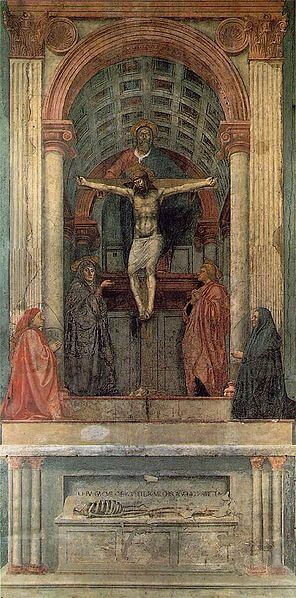
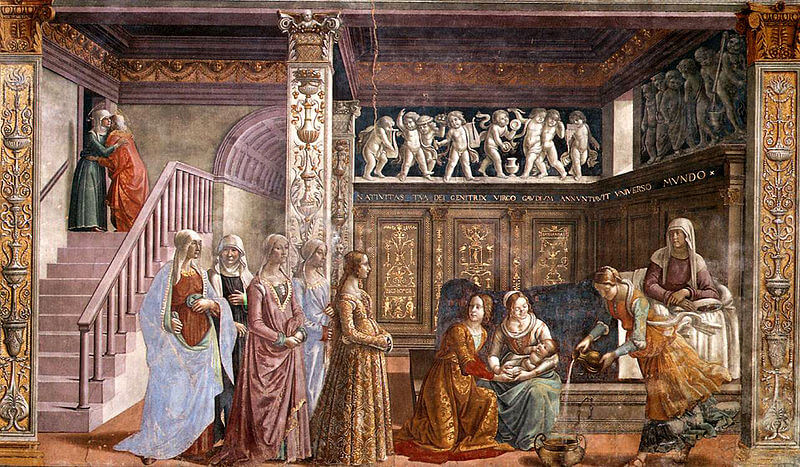
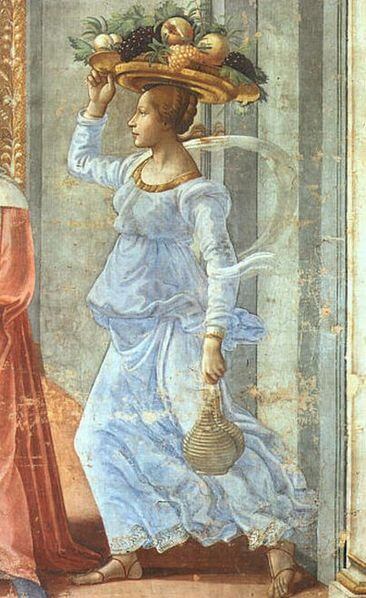
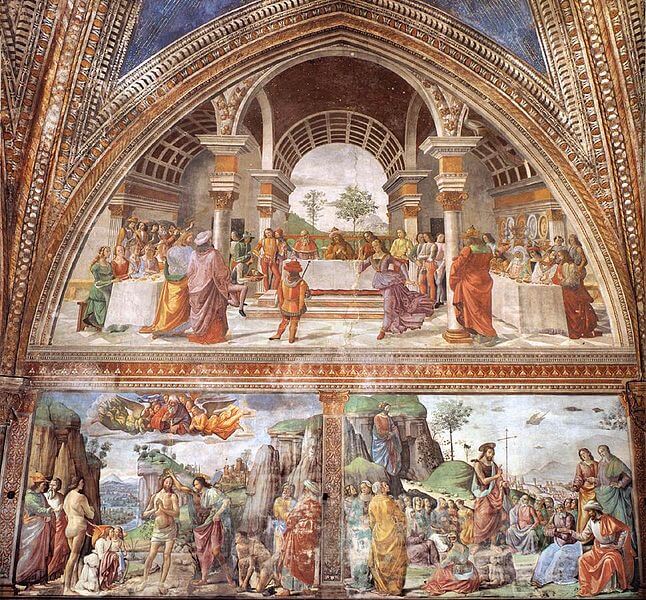
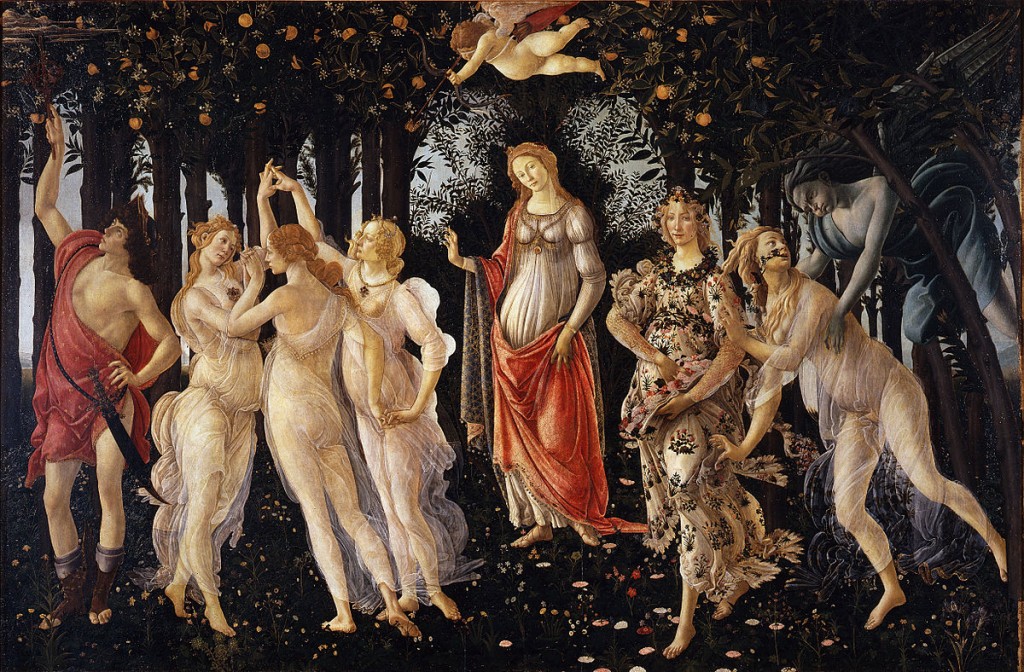
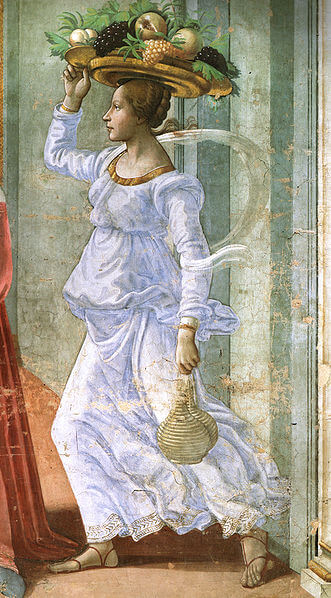

Thank you so much, Jenna, for such a marvelous description of the Santa Maria Novella church. We are returning to Florence in September and will revisit this church, largely because of your detailed description.
Another place we will likely revisit is the Ognissanti church cloister and refectory, which contains a “Last Supper” by Ghirlandaio. One one side of the cloister is a short double staircase with a small plaque, showing the heights of two major floods a century apart. It is one the opposite side from the entrance to the refectory. When we have visited, it has been almost empty.
Here’s a link to information about the Ognissanti “Last Supper” and many others in Florence: http://www.paradoxplace.com/Perspectives/Italian%20Images/Montages/Firenze/Last%20Suppers.htm.
Suzy, Thank you for the link and the information. I have seen the Andrea del Castagno last supper, which is an interesting and unique one, but have not seen the others. I will definitely visit the Ognissanti cloister and refectory to see Ghirlandiao’s “Last Supper” and the flood marks next time I’m in Florence.
There are so many treasures in Florence, and I love to explore some of the opportunities to see things that are less visited.
Jenna: I also really enjoyed reading this information and the details. You have posted several times to my string (Ohno – 3-4 weeks in Florence) and offered some art history guidance. I had next to no art history education growing up and feel like my trip to Florence (now scheduled for May 2011 probably) would be my chance for exposure. I am worried about being overwhelmed but your explanations above I found really interesting and informative; not overwhelming. It is obvious this is your passion. Thank you, Linda
Hi Linda! I’m glad to see that you discovered this post about the art in Santa Maria Novella. I’m also glad that you found it accessible and not overwhelming! As a professor (of English, not art), I have learned that overwhelming and complicated explanations are rarely useful to others. When I prepare that little guide to the art in Florence that I mentioned to you before, it would be something similar but with a few more places, of course.
I will post more about Florence in the future, so check back once in a while. 🙂
Thanks for stopping by and best of luck with trip planning.
Jenna
Jenna: You are wise I think, to have found a key to getting your “student” interested in learning more about art. You are so right that overwhelming instruction is sort of defeating – this way, you have made it interesting and informative and make me more interested in learning instead of feeling overwhelmed and giving up on the idea. I just watched a video yesterday called “Florence: The Cradle of the Renaissance” that was interesting but a little dry. I watched it a second time to try to get the correct pronounciation of some of the sites although the lady narrating was an older English lady with a strong accent and a high pitched voice that made it a bit hard to understand sometimes.
I’m using a comprehensive approach – novels set in Florence, videos both educational and travelogues, blogs, boards etc. When it gets closer I will be taking a Traveler’s Italian language class (tried tapes without success). Thanks again. Linda
Linda,
Just to clarify, I actually teach English, not art, although I studied art in school and it’s my bigger passion. But as a language teacher, I have to tell you that you’re right about taking a language class instead of trying to learn at home with tapes. Anything interactive will be much more effective than trying to learn on your own.
I like your comprehensive approach. With the videos, try the PBS Empires, the Medici series that I think I mentioned on the frommers board. You can watch them for free on hulu.com. I watched them about 30 mins. at a time and found them really informative and they helped me see how life really was in Florence and Italy in the past.
Jenna
Piter,
Thanks for the compliment. Yes, this is my hobby, and don’t apologize for your English! Come back and comment anytime!
Florence is one of my favorite cities as well. I also studied abroad in the Renaissance city. Around every corner is a work of art. Thanks for the revisit to Santa Maria Novella Church, one I passed by many times. Great information here as well. One of my favorite places in Florence for art is the Pitti Palace. The amount of artwork on the walls is overwhelming but inspiring at the same time. You walk passed a Velazquez that is crowded in with all of these other paintings. Pretty remarkable place I’m sure you visited being an art history fan.
Suzy, Thanks for stopping by and commenting.
I think anyone who is fortunate to spend an extended amount of time in Florence would love it. You’re right– there’s a work of art around every corner. Thanks for mentioning the Pitti Palace. It is an amazing museum, and I like that it’s in the palace. Everyone goes to the Uffizi, but the Pitti Palace is definitely worth visiting. And the Boboli Gardens–I saw your article about it, so I know you know what I’m thinking– a wonderful place to spend a day!
Jenna- I am leaving on Wednesday for Italy (frist trip) and we are actually staying at a hotel across a piazza? fromt this church! I am so glad I stumbled onto your post/website and will absoutely make a point to go inside now- it so beautiful and your descriptions make me want to go explore it. Thank You!
Hope
Hope, Thanks for your comment. I stayed just off that piazza once. It is a very convenient location. Just be aware that that square can be a little shady sometimes. I hope you saw my other post about 5 things to do in Florence. Have a wonderful trip!
Hi Jenna
Thanks for participating in #ArtWednesday, which is how I found your post. I’m retweeting it later tonight – it’s great. I wonder in fact why i haven’t already written about SMN and all the great things inside. Anyway I’m thrilled that someone else posted about Florence on this occasion!
I write the blog TuscanyArts – it’s an official project of the Regione Toscana. I’m actually a professor of art history turned social media addict, and I started #ArtWednesday. Did you hear about it through Slow Art? or… ? You’ve got a nice blog here, i’m now going to spend some time reading and trying to figure out where you teach English ;-).
cheers, Alexandra
(ps – if you’re on facebook look me up – and/or become a fan of Tuscany Arts should you so wish)
Hi Alexandra,
I don’t remember exactly how I heard about artwed. Someone I follow mentioned it in a tweet this morning, and I decided to join in! So glad I did!! I would write about art more if I had more time.
I have enjoyed your blog for a few weeks already. I found it when I started looking at Tuscany blogs a month or 2 ago. A blog about Tuscany and art is like finding a pot of gold for me. 🙂
And I’ll become a fan of TuscanyArts for sure! Thanks so much for stopping by!
Hi Jenna. I’m the one you said you would write up a little art history lesson for Florence for many many months ago on Frommer’s Italy board. I leave April 25, 2011 and will have a month in Florence. I’m hoping you will have the time to send me your thoughts. I’m still having a great deal of trouble with my feet (and knees) and will be getting a cortisone shot in each foot prior to leaving. Still, I will have limited time each day to be out and about but I’m very excited about the trip. If you are unable to do the write up please do not feel bad, but if you can I will really appreciate it. Linda
IHi Linda! I’m working on it! I’ll get back to you soon with some kind of update at least.
Oh, great Jenna! I just got off the phone from a friend who is going with me (her and her husband, who will have a separate apt and do some traveling independently while there). She just told me 4 other friends of theirs are going to be in Florence our last few days, so I can share the info you provide and you will be helping several of us. The trip will be here before I know it (hope I’m ready)! Thanks again. Linda
Thanks for such a great post.
My wife and I have three days in Florence in early March, and I’m currently drawing up a shortlist of places to visit using your ’30 ideas’ post.
It’s great to have some recommendations outside the standard guidebook offerings.